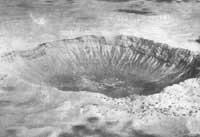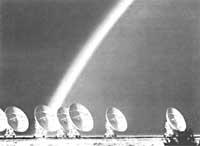Asteroid by the Earth
1989/11/01 Arregi Bengoa, Jesus Iturria: Elhuyar aldizkaria
Last summer we had two main news in the field of astronomy: in July, the 20th anniversary of the arrival of man to the Moon and in August, bringing Voyager 2 to Neptune. The day after the Voyager Pass at a minimum distance (4,800 km) from Neptune, on August 25, an asteroid of half a mile and a half passed to 4 million kilometers from Earth. If we compare distances, it seems logical that this last news does not have a great impact.
However, on an astronomical scale this distance (passing a tenth to the Moon) can be considered brief. To compare we will say that during these months Martitz will travel about 345 million km. Therefore, we could say that it has passed closely, even more considering the consequences that would have on Earth the collision with an asteroid of the measure cited above. But before describing these catastrophic effects, we must give some indications about the nature of meteorites and asteroids.
Bodies that are in danger of collision around the Earth are called meteoroids; they are fractions of dust, major rocks, comets, asteroids or what they are. If after the crash there is some residue on the surface of the Earth, it is called meteorite. For meteoroids to be heated by atmospheric friction and not completely burned, they must have minimal dimensions. Its mass should be 10 kg.

Slightly large meteoroids are usually asteroids. These are the numerous bodies or planetoids that orbit halfway between the paths of Martitz and Jupiter. The largest is Ceres, with 780 km in diameter, but most of them (thousands of cataloged) are much smaller. It is believed that they were formed with matter that could not be condensed to form a planet and that some have eccentric orbits approaching Earth.
Asteroids, and in general residual matter, were abundant in interplanetary space as a result of the creation of the Solar System. Therefore, collisions between them and planets were frequent. Most of the craters, so characteristic of the Moon, are the result of these collisions, with a diameter of more than one hundred kilometers. Other planets suffered a similar bombardment, but with the exception of Mercury and Martiz today the scars are scarce. In particular, the cause of not being discovered on Earth and on Venus, and of the scarce existing ones being large, is due to the fact that it slows down the fall even though the meteorite is large and cannot produce great effects, and that by erosion it distorts the craters in a relatively short time.
After hundreds of thousands of initial years, interplanetary space was cleared far less than the aforementioned region, but it is not uncommon for a large asteroid to occasionally approach the surroundings of Earth, especially if as a result of the collision or leaving its original orbit it has taken another very eccentric.
Of course, the probability of a collision between Earth and an asteroid in such a large space is very low: it is estimated that it could occur every 100,000 years, but craters that have been found after studies conducted by artificial satellites confirm the risk. Craters of all sizes have been formed according to the dimensions of meteorites, but those that have been maintained to date have been the most recent and the largest of the old. The latter are much larger than those of volcanoes, for example, Vredefort Dam in South Africa is 120 km in diameter. It is estimated that the terrestrial surface is formed by meteorites of 2 or 3 km of diameter at 20 km/s about 2,000 million years ago.
The Sudbury Crater in Canada is also very large. It is 100 km in diameter and at 1.8 billion years it is somewhat younger than the previous one. However, they are much more recent and the best known is the Meteor Crater. It is located in Arizona, USA, with a radius of 1,200 m, a depth of 170 m and about 20,000 years.
The damage that an asteroid can cause when falling to Earth depends on its size and speed, its angle of impact and the conditions of the environment in which they affect. In general, side effects are more harmful than those of a single shock. For example, for many astronomers and paleontologists the destruction of dinosaurs occurred when about 45 million years ago an asteroid of 10 or 12 km in diameter fell. According to them, when the asteroid fell on the solid surface of the Earth caused a huge explosion causing the fission of certain radioactive elements and the simultaneous opening of thousands of volcanoes. Both the explosion itself and the clouds of dust thrown by the volcanoes covered the Sun for a long time, generating a winter that lasted decades and killing larger plants and animals that were based on food.
As mentioned above, the Vredefort Dam crater has been built by an asteroid of 2 or 3 km in diameter, falling to 20 km/s. Of this size or of the kilometer and a half that happened last August, if it fell to the sea, there were waves of ten or a hundred meters that would cause a spectacular tsunami. Of course, the coastal area would be affected.
August is not the only asteroid seen this year around Earth. On 23 March, the asteroid called FC 1989 went to 745,000 km (just over twice the distance from Earth to the Moon). As there are tools to find and follow these types of bodies, this body of about a kilometer in diameter broke the approximate record of a planetarium of a certain size, which in 1937 passed to the 773,000 kilometers of Hermes (800 meters in diameter).
In addition, 1989 Asteroid FC can pose serious problems in a relatively close future, according to British and Soviet astronomers. This asteroid approached us earlier (detected in 1983) and according to the calculations of its orbit will be destroyed with Earth. The different forecasts are around 100 years old and those who announce the closest shock date the year 2015.
Given the above conclusions, we may not be facing an unimportant problem. Some scientists have already talked about ways to avoid this shock. However, nobody seems easy to exploit the planetarium in space by a nuclear charge or divert it by controlled explosions.

Gai honi buruzko eduki gehiago
Elhuyarrek garatutako teknologia



